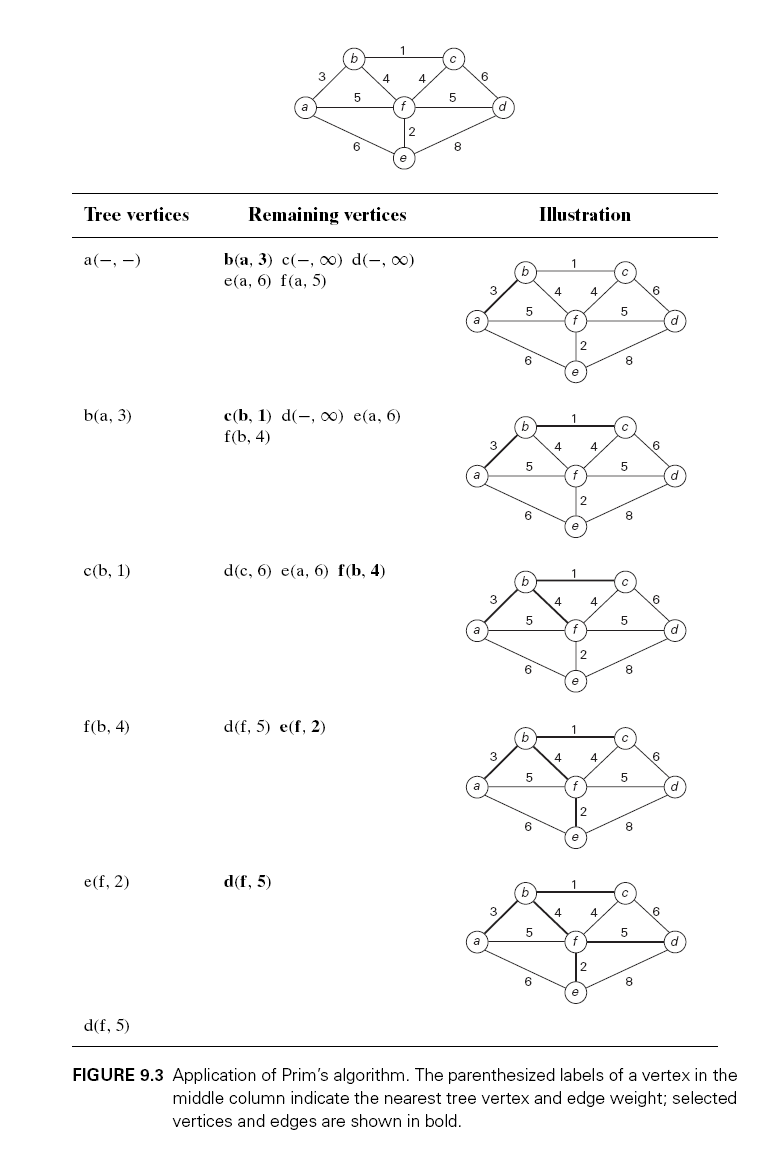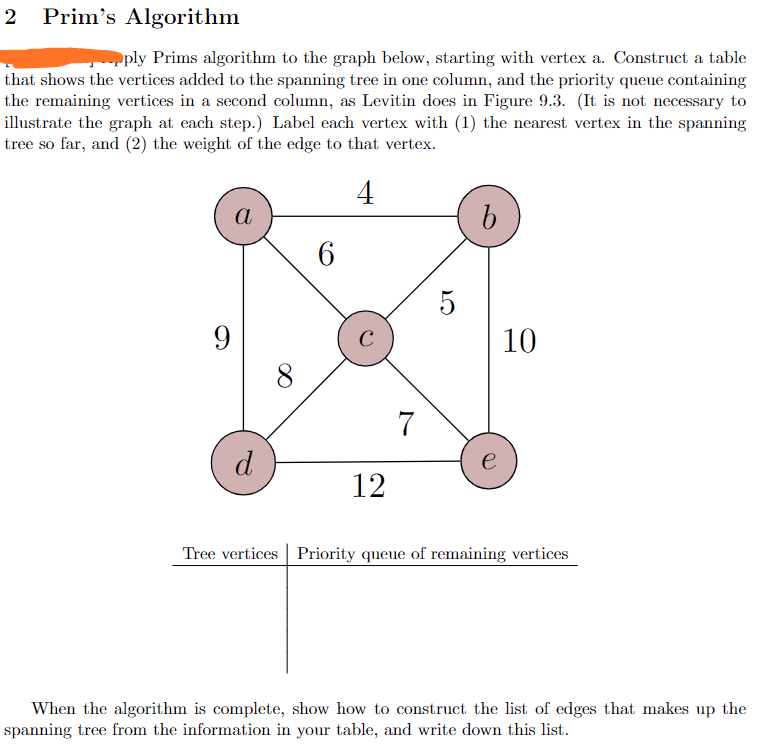ply Prims algorithm to the graph below, starting with vertex a. Construct a table that shows the vertices added to the spanning tree in one column, and the priority queue containing the remaining vertices in a second column, as Levitin does in Figure 9.3. (It is not necessary to illustrate the graph at each step.) Label each vertex with (1) the nearest vertex in the spanning tree so far, and (2) the weight of the edge to that vertex. 4 9 a d 6 C 12 7 5 b e 10 Tree vertices Priority queue of remaining vertices When the algorithm is complete, show how to construct the list of edges that makes up the spanning tree from the information in your table, and write down this list.
ply Prims algorithm to the graph below, starting with vertex a. Construct a table that shows the vertices added to the spanning tree in one column, and the priority queue containing the remaining vertices in a second column, as Levitin does in Figure 9.3. (It is not necessary to illustrate the graph at each step.) Label each vertex with (1) the nearest vertex in the spanning tree so far, and (2) the weight of the edge to that vertex. 4 9 a d 6 C 12 7 5 b e 10 Tree vertices Priority queue of remaining vertices When the algorithm is complete, show how to construct the list of edges that makes up the spanning tree from the information in your table, and write down this list.
Database System Concepts
7th Edition
ISBN:9780078022159
Author:Abraham Silberschatz Professor, Henry F. Korth, S. Sudarshan
Publisher:Abraham Silberschatz Professor, Henry F. Korth, S. Sudarshan
Chapter1: Introduction
Section: Chapter Questions
Problem 1PE
Related questions
Question
Please only typed answer fast

Transcribed Image Text:Tree vertices
a(-,-)
b(a, 3)
c(b, 1)
f(b, 4)
e(f, 2)
d(f, 5)
3
5
6
d(f, 5) e(f, 2)
d(f, 5)
4
Remaining vertices
b(a, 3) c(-, ∞) d(-, ∞)
e(a, 6) f(a, 5)
c(b, 1) d(-, ∞) e(a, 6)
f(b, 4)
d(c, 6) e(a, 6) f(b, 4)
2
4
5
8
3
3
5
5
6
5
6
5
6
5
6
Illustration
4
4
4
4
4
1
2
2
2
f
4
4
2
4
4
4
с
5
8
5
8
5
5
8
5
8
6
6
6
6
FIGURE 9.3 Application of Prim's algorithm. The parenthesized labels of a vertex in the
middle column indicate the nearest tree vertex and edge weight; selected
vertices and edges are shown in bold.

Transcribed Image Text:2 Prim's Algorithm
ply Prims algorithm to the graph below, starting with vertex a. Construct a table
that shows the vertices added to the spanning tree in one column, and the priority queue containing
the remaining vertices in a second column, as Levitin does in Figure 9.3. (It is not necessary to
illustrate the graph at each step.) Label each vertex with (1) the nearest vertex in the spanning
tree so far, and (2) the weight of the edge to that vertex.
4
9
a
d
6
C
12
7
b
e
10
Tree vertices Priority queue of remaining vertices
When the algorithm is complete, show how to construct the list of edges that makes up the
spanning tree from the information in your table, and write down this list.
Expert Solution
This question has been solved!
Explore an expertly crafted, step-by-step solution for a thorough understanding of key concepts.
This is a popular solution!
Trending now
This is a popular solution!
Step by step
Solved in 2 steps with 1 images

Knowledge Booster
Learn more about
Need a deep-dive on the concept behind this application? Look no further. Learn more about this topic, computer-science and related others by exploring similar questions and additional content below.Recommended textbooks for you

Database System Concepts
Computer Science
ISBN:
9780078022159
Author:
Abraham Silberschatz Professor, Henry F. Korth, S. Sudarshan
Publisher:
McGraw-Hill Education

Starting Out with Python (4th Edition)
Computer Science
ISBN:
9780134444321
Author:
Tony Gaddis
Publisher:
PEARSON

Digital Fundamentals (11th Edition)
Computer Science
ISBN:
9780132737968
Author:
Thomas L. Floyd
Publisher:
PEARSON

Database System Concepts
Computer Science
ISBN:
9780078022159
Author:
Abraham Silberschatz Professor, Henry F. Korth, S. Sudarshan
Publisher:
McGraw-Hill Education

Starting Out with Python (4th Edition)
Computer Science
ISBN:
9780134444321
Author:
Tony Gaddis
Publisher:
PEARSON

Digital Fundamentals (11th Edition)
Computer Science
ISBN:
9780132737968
Author:
Thomas L. Floyd
Publisher:
PEARSON

C How to Program (8th Edition)
Computer Science
ISBN:
9780133976892
Author:
Paul J. Deitel, Harvey Deitel
Publisher:
PEARSON

Database Systems: Design, Implementation, & Manag…
Computer Science
ISBN:
9781337627900
Author:
Carlos Coronel, Steven Morris
Publisher:
Cengage Learning

Programmable Logic Controllers
Computer Science
ISBN:
9780073373843
Author:
Frank D. Petruzella
Publisher:
McGraw-Hill Education